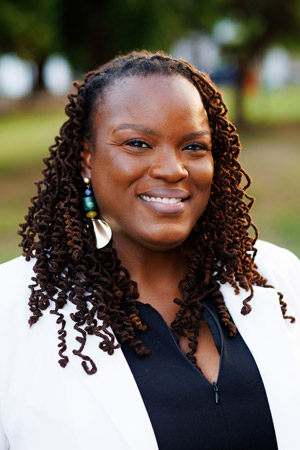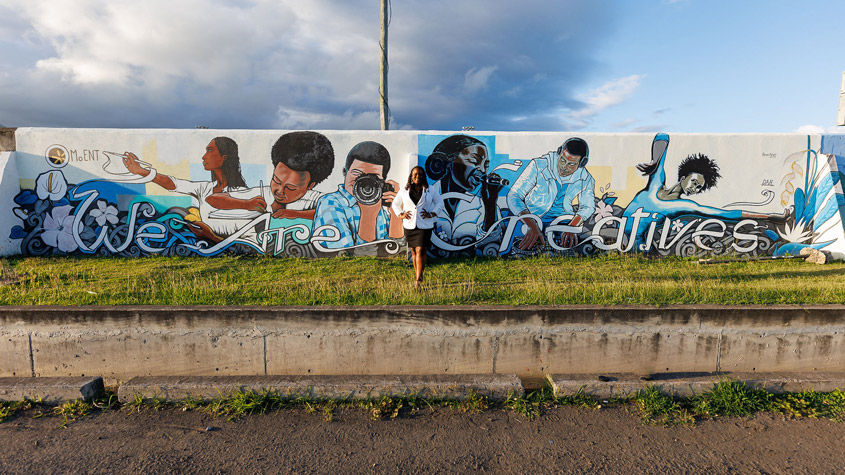
Harnessing the value of creativity in the Caribbean with IP
By Paul Omondi, Freelance writer
Jihan Williams calls herself a multi-layered Caribbean woman because of her multiple interests in the arts, advocacy, and law. Her passion for intellectual property (IP) law catapulted her to the helm of St. Kitts and Nevis IP office as the Registrar. In this interview, she talks about the importance of IP for the creative industry and economic growth in the Lesser Antilles and her foray into publishing.

How did you get into the field of intellectual property?
My interest in IP started with my love for art and entertainment. I was also inspired by the late Masud Sadiki, who was a popular musician in my country. He encouraged me to learn about music contracts and royalties and to explore how artists can protect and benefit from their work. His passion and faith in me influenced my decision to pursue a master’s degree in IP law.
Why is IP important for young people?
Young people are very creative, and they should be IP-aware so they can protect their creativity and understand how to earn income from it. It’s exciting to know that through IP it’s possible for them to thrive without owning physical collateral or having tons of money to begin with. Your mind and talents are the keys, at any age. It is also important that young people understand how the IP system works so they don’t infringe the rights of other creators when they use their works.
Young people are very creative, and they should be IP aware so they can protect their creativity and earn income from it.
How has IP influenced the arts scene in St. Kitts and Nevis?
In St. Kitts and Nevis, we are music lovers. We have so many talented and upcoming musicians. IP is increasingly shaping the industry, especially through copyright cases. There was a lot of interest in the Marvin Gaye Estate v Robin Thicke and Pharrell Williams over the latter’s Blurred Lines song that was found to have infringed the copyright of Marvin Gaye’s 1977 Got To Give It Up hit. Our musicians are showing interest in IP because of this and similar cases that have been popping up in the region. Creatives are asking questions like never before in St. Kitts and Nevis. That’s very encouraging and makes it easier for us to raise awareness about IP.

What's the potential of IP and the creative industry in supporting economic development in St. Kitts and Nevis and the Caribbean in general?
Entertainment is a big industry in the Caribbean, and we have many talented artists - from disc jockeys, musicians, songwriters to producers. The potential of IP is big, and the region has begun to recognize this. That’s why the Orange Economy is a priority in the Caribbean and an important component of our development agenda, especially because of the many opportunities available for the youth. Our role as an IP Office is to build a vibrant IP framework for young people and our creative industry to thrive.
Our role as an IP Office is to build a vibrant IP framework for young people and our creative industry to thrive.
This has also been true for you. What does writing and being an author mean to you?
I am very passionate about writing. I encourage those interested to also write and protect their work. I find writing is more than telling and documenting stories, it’s also cathartic. After my miscarriage at the age of 37, I started to write as a way to process my emotions. That was the beginning of my healing process.

Please tell us about your book.
The book is titled Lifting the Weight of Miscarriage: Healing Insights for Pregnancy Loss Sufferers and the People Around Us. It is an emotional recount of my journey following my miscarriage in the second trimester. In it, I share my physical, emotional and spiritual experiences and offer coping and healing suggestions for people, and their loved ones, who have gone through this loss. I wanted help and guide other women by what helped me during this painful episode. It is inspiring to see the book encourage other women to share their experiences. I am also very happy to see my book is helping men too, by shining a light on the pain of miscarriage that men also go through as fathers.
Why did you choose to self-publish?
I self-published because I wanted to be in full control of the process, from the narration style, and title, to cover design. I wanted to be as authentic as possible in telling and packaging my story without jumping through the hoops of a book publisher’s demands. Importantly, I had set a tight deadline to launch the book on November 23, 2022, the first anniversary of my loss, to honor my son.
What motivated you to set up Bouncing Daughter Publishing?
The name is inspired by my father’s nickname, “Bouncing.”. Bouncing Daughter is an ode to my dad and reflects my many interests, which I often “bounce” to and from, such as the arts, IP, law and advocacy. I set up the company to serve my ambitions as a writer. I have learned a lot in the process, from collaborating with teams of designers and editors to acquiring an International Standard Book Number (ISBN), marketing and putting the book up on Amazon and Kindle. I am also considering an audiobook version of the book.
Do you have another book in the pipeline?
I am currently toying with the idea of writing a simple and easy-to-understand guide on IP for entrepreneurs. After that I might even consider a book for children, to get them thinking about IP at an early age, since with IP you can earn from your work regardless of your age. Children are very creative and experiment a lot from building and creating things. The aim is to enable them to understand the basic concepts of IP as they begin to explore their creative talents. We need more creators and not just consumers.
The WIPO Magazine is intended to help broaden public understanding of intellectual property and of WIPO’s work, and is not an official document of WIPO. The designations employed and the presentation of material throughout this publication do not imply the expression of any opinion whatsoever on the part of WIPO concerning the legal status of any country, territory or area or of its authorities, or concerning the delimitation of its frontiers or boundaries. This publication is not intended to reflect the views of the Member States or the WIPO Secretariat. The mention of specific companies or products of manufacturers does not imply that they are endorsed or recommended by WIPO in preference to others of a similar nature that are not mentioned.